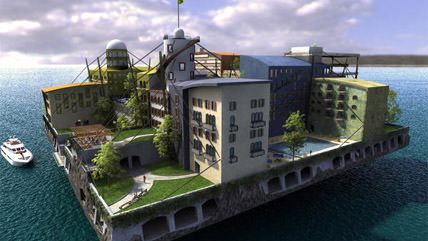Habitats for Freedom
Seastead engineerings

Aiming to develop habitations at sea that are safe and practical while enabling "experimentation with alternative social systems," the Seasteading Institute has hired the Dutch engineering firm DeltaSync. When the company delivered initial designs and specifications in December 2013, the dream of floating political experiments moved closer to reality.
DeltaSync's Seasteading Implementation Plan assumes that early efforts will be anchored in sheltered harbors-specifically, the Gulf of Fonseca, bordering El Salvador, Honduras, and Nicaragua. The modular design is intended to be mobile, however, and potentially suitable for deep-sea location if surrounded by a breakwater.
The first-draft design uses concrete modules, 50 meters by 50 meters, each with a population of 225 people. The modules could be moved by tugboat and linked as needed. Algae farming, aquaculture, and aquaponics would provide fresh vegetables, so that at least some food could be locally sourced. Rainwater would be collected for freshwater and as an alternative to energy-intensive desalination or importation. Energy comes from solar collectors, with battery storage and backup diesel generators.
Many social and political barriers remain to creating independent or semi-independent communities at sea. But more and more, the engineering and economic hurdles are being overcome.


Show Comments (3)